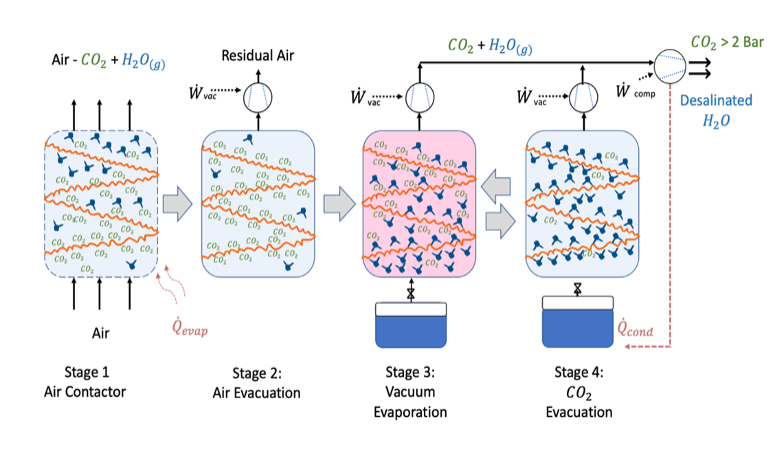Advancing Direct Air Capture Technology: Autothermal Vacuum Moisture Swing (aVMS) Modeling and Novel Sorbent Application
Sinyangwe, S. Guzzo, M. Patil, P. Schulze, M. Green, K. Lackner, J. Flory, J.L. Wade
This research project explores the development and optimization of an autothermal Vacuum Moisture Swing (aVMS) technology for direct air capture (DAC), with the aim of contributing to global efforts toward negative emissions [1]. Current climate challenges necessitate sustainable solutions to combat rising Carbon Dioxide (CO2) levels in the atmosphere, and DAC presents a promising avenue. However, existing DAC technologies such as Temperature Vacuum Swing (with an average heat of sorption estimated at 80 kJ/mol of CO2) face limitations in terms of energy, sorbent degradation, and capital intensity [2]. The proposed aVMS technology addresses these challenges by utilizing a combination of moisture-driven and thermal-driven sorbents (heat of sorption reported at 32 kJ/mol) with the ability to operate under near ambient conditions [2].
In moisture-driven sorbents, the presence of water in the sorbent shifts the equilibrium isotherm favoring CO2 in the gas phase while generating heat from exothermic water sorption. These moisture sorbents are mostly polymeric materials featuring fixed cationic sites that charge balances the carbon-based mobile anions (bicarbonates and carbonates) [3]. Fundamentally, the mechanism revolves around the stability shift between hydrated bicarbonate and carbonate ions upon increasing moisture. The autothermal sorption heating from water not only promotes the release of CO2 from the sorbent but negates the dependence on fossil-based energy for CO2 desorption thereby representing a low energy, fossil free CO2 removal process.
A comprehensive assessment on moisture-based regeneration of direct air capture sorbents is conducted through the development of a 4-step transient cyclic numerical model (Figure 1). This model comprises four key stages: i) the adsorption stage, where ambient air flows over the sorbent enabling CO2 capture, ii) the air evacuation stage, involving the application of vacuum to remove excess air thereby enhancing CO2 purity, iii) the vacuum evaporation stage where the applied vacuum facilitates the evaporation of low grade water into the sorbent matrix and iv) desorption where an even lower vacuum pressure is applied to remove the desorbed CO2 from the heat generated during water sorption. The utilization of computational fluid dynamics and adsorption reaction kinetic principles ensures the accuracy and reliability of the numerical model which is calibrated and validated against data from dynamic breakthrough and desorption experiments. In addition to simulating a DAC operation, this numerical model will serve as a tool for optimization aimed at minimizing energy penalty (kJ/mol), reducing water load (H2O:CO2), maximizing productivity (mol CO2/m3.hr), increasing sorbent lifecycle efficiency (g CO2/g sorbent) and minimizing overall DAC + utilization costs (e.g.$/L fuel or $/t CO2 sequestered).
The successful development of aVMS technology offers a more efficient and sustainable DAC solution. This advancement could yield positive impacts on stakeholders, policymakers, and industries, potentially driving widespread adoption of DAC. Overall, this work aims to advance DAC technology and contribute to global climate mitigation efforts.
References
[1] “Carbon neutrality by 2050: the world’s most urgent mission | United Nations Secretary-General.” Accessed: Jan. 13, 2024. [Online]. Available: https://www.un.org/sg/en/content/sg/articles/2020-12-11/carbon-neutrali…
[2] F. Sabatino, A. Grimm, F. Gallucci, M. Van Sint Annaland, G. J. Kramer, and M. Gazzani, “A comparative energy and costs assessment and optimization for direct air capture technologies,” Joule, vol. 5, no. 8, pp. 2047–2076, Aug. 2021, doi: 10.1016/j.joule.2021.05.023.
[3] X. Shi, H. Xiao, K. Kanamori, A. Yonezu, K. S. Lackner, and X. Chen, “Moisture-Driven CO2 Sorbents,” Joule, vol. 4, no. 8, pp. 1823–1837, Aug. 2020, doi: 10.1016/j.joule.2020.07.005.


